Why You Should Use a Fisheye Lens for Wide Angle
Jun 03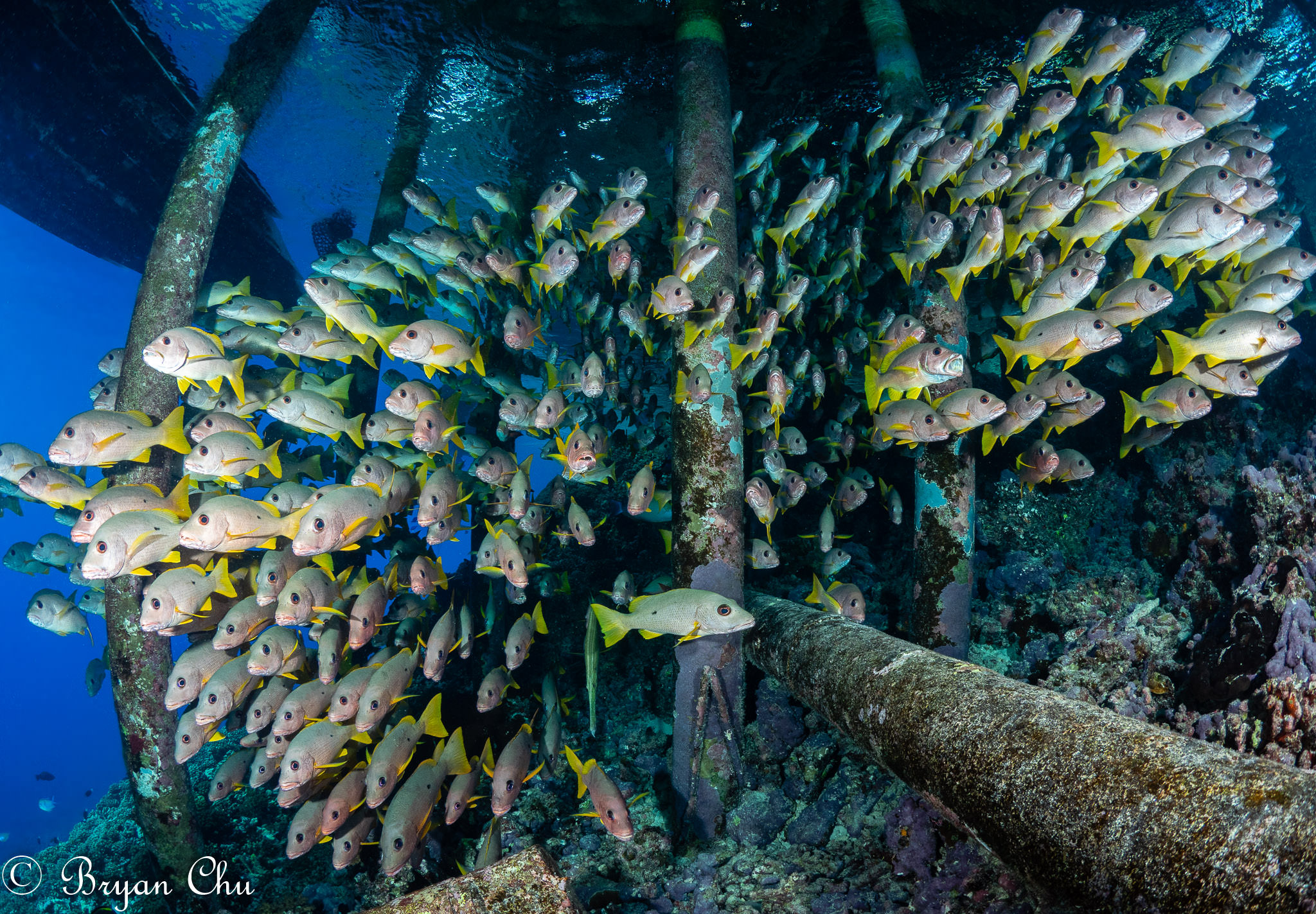
I shoot with an Olympus OM-D E-M1 in a Nauticam E-M1 Mark II housing, and whenever I am shooting wide angle I use the Olympus 8mm f/1.8 fisheye lens. I run into a lot of people who either don’t use a fisheye lens at all, or who think it is a specialty lens that you only use for big things like mantas, whale sharks or humpbacks.
Yes, fisheye lenses are definitely the best for giant subjects like that, but they are incredibly useful for a lot of other situations as well. Although fisheye lenses are used more as art lenses or for niche applications on land, underwater, it’s a different story. Rather than the fisheye being the specialty lens, underwater I think of the fisheye lens as the default wide angle lens, while non-fisheye wide-angle lenses are the specialty lenses.
Fisheye Lenses 101
The first thing to understand about fisheye lenses is what sets them apart from normal wide angle lenses. The big difference is that they have an enormous field of view – typically, 180 degrees! Compared to the 75 – 114 degree field of view of the 7-14mm f/2.8 Olympus wide angle lens, the 8mm fisheye’s 180 degree field of view is much more (plus it is significantly smaller and cheaper).
To be able to create this massive field of view, the fisheye lens warps the image, with the warping most pronounced at the edges of the image. For more of a comparison between the two types of lenses, check out this very detailed article on fisheye lenses vs wide-angle.
Wide Angle Shooting Basics
When shooting wide angle underwater, you always want to be as close to your subject as possible (while still having a nice composition). The closer you are, the less water between you and your subject, meaning the subject is sharper. Additionally, the less distance your strobe lights have to travel between your camera and the subject, and then back to your camera, the brighter and truer the colours will be.
If your strobe light has to travel 4 ft to the subject and 4 ft back, you will have a lot less color (especially reds) than if your strobe light only has to travel 2 ft in each direction. Of course, the fisheye lens is the best at getting you as close as possible to your subject. Additionally, the barrel distortion of the lens, which can be very difficult to use above land, works great underwater, where there are very few straight lines.
Below is a collection of my favorite shots taken with my fisheye lens, as well as some explanation about why the fisheye made them so great.
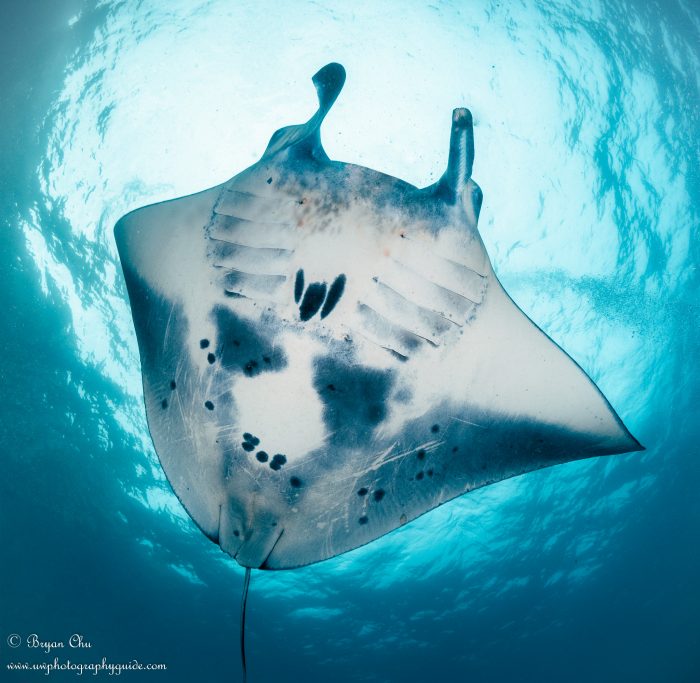
Manta ray belly taken at Manta Point, Nusa Penida, Bali. The water was pretty murky there, as it is at most manta dive sites. The only way I was able to get the belly so sharp and detailed, and have the nice lighting, was by shooting with my fisheye lens in my underwater housing and being only about 3 feet below this manta as it passed over me. With a wide angle lens, I would have had to be much further away to get the whole manta in the frame, meaning less clarity, more backscatter, and poorer lighting.
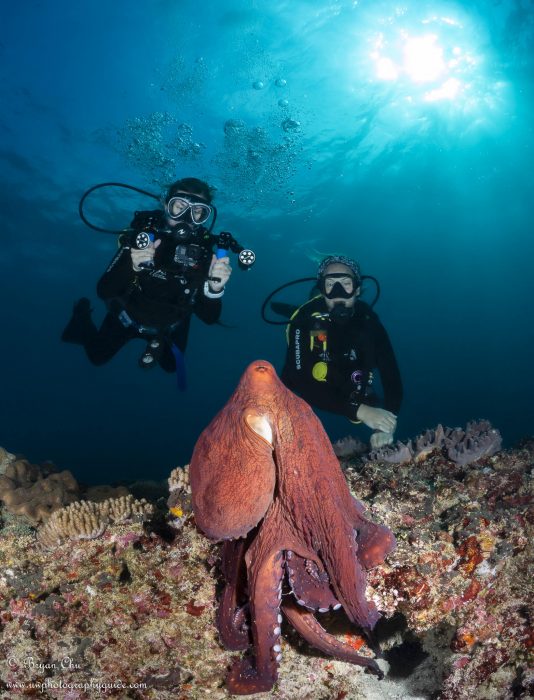
Octopus in Manta Bay, Nusa Penida, Bali. The fisheye lens allowed me to get very close to this octopus, bringing out the detail in it, but also to include two dive models in the photo, and bring the sun into the composition. I did this by getting low and shooting up. Without a fisheye lens I would have had to be further back from the octopus just to get the two dive models in the photo, and would not have also been able to include the sun. There was not enough space to get that far back and that low for the same composition. Without the sun, this photo loses an important point of interest, and becomes just a decent photo rather than one that really pops.
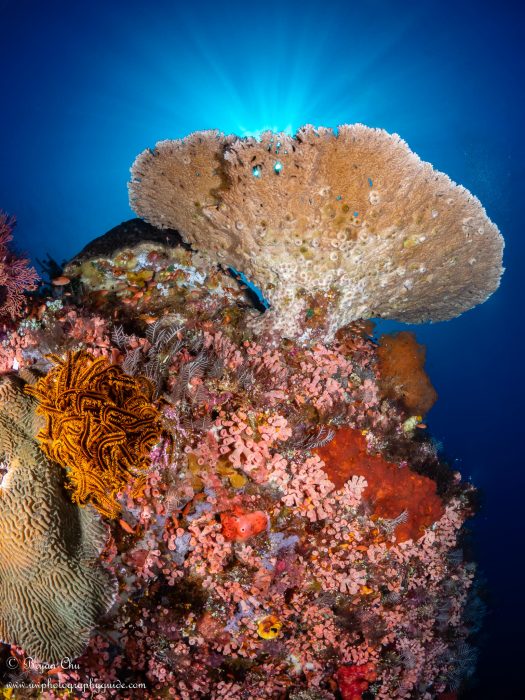
Coral at Crystal Rock, Komodo. The fisheye lens allowed me to get very close to the coral and rock, within less than two feet. This meant I could stop down my camera to f/18 and max my shutter speed at 1/320s to bring out the details in the sun, but I was close enough to my subject that I could still light it very brightly with my strobes. When I tried this shot 2-3 feet further back, which is what I would have had to do with a wide angle lens, my YS-D1 strobes at maximum power could not illuminate the coral and rock properly.
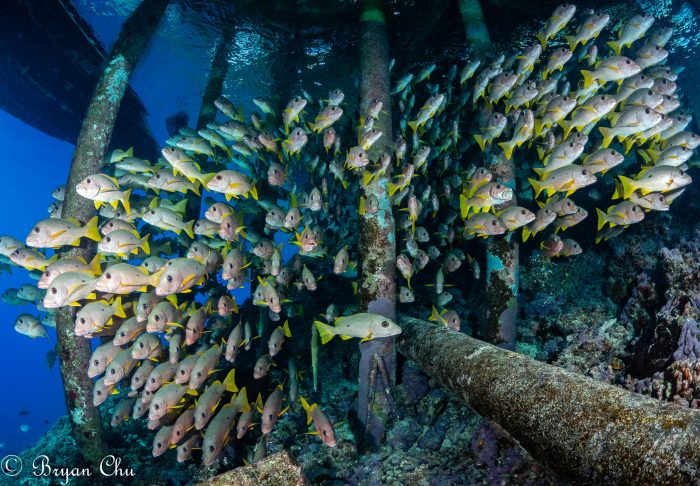
School of fish beneath the jetty at Tetamanu Village, Fakarava South Pass, French Polynesia – one of our 5 “scuba diving bucket list” destinations. Without my fisheye lens, there is no way I could have been far away enough from these fish to get them all in the frame with a nice shape, and close enough to light them properly with my strobes. This shot was taken about 3-4 ft in front of them. The added bonus of the fisheye is that with the exaggerated perspective it creates, it amplifies the “3D” effect where it feels like the fish in the water are coming right at you out of the image.
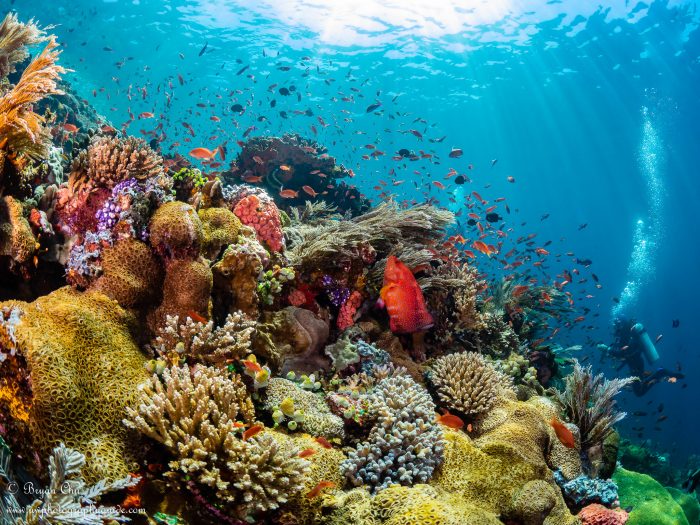
A beautiful reef scene at Batu Bolong, Komodo…one of the nicest sites I have ever dove. Same as above…sun rays, beautiful colors, sharpness…only a fisheye can start to do justice to a spectacular reef scene like this. No matter what I did I could not get a photo which really did this site justice, but at least the fisheye gave me a fighting chance.
I have lots of other examples, but I think these shots give a good idea of some of the reasons why I love shooting with a fisheye lens, and why if you don’t have you, you really should pick one up for your rig – assuming your underwater camera supports a fisheye lens.
Which is Right for You?
When people are just getting started and they ask me whether they should get a fisheye lens or a wide angle lens, I ask them this question. Do you want to be able to get a lot of decent photos, especially of skittish pelagic subjects? Or do you want to get a lower number of decent photos, and have some frustrations with skittish pelagics, but instead be able to get some really amazing, extraordinary shots?
If you want the former, then go with a plain wide angle lens. But if you want to get those shots that make people go “Wow” when they see them, the shots that can win awards, and are OK dealing with some frustrations, then it’s fisheye all the way!
Some Great UW Photo Destinations…
And if you want to travel and do some great diving where amazing wide angle opportunities await you on every dive, definitely check out the places where I took these shots:
- Bali Dive Travel Guide
- Bali Hai Diving Adventures – amazing resort, small groups, excellent boat and guides. Beat the rush to manta point by staying on Nusa Lembongan, so you can get there ahead of all of the day boats from Bali!
- Komodo Diving Guide
- Dragon Dive Komodo – budget diving in Komodo, but with top-notch guides with a heavy focus on safety, small groups, and customizing experiences for people based on skill level and experience.
- French Polynesia Diving Guide
- Tetamanu Village – spectacular walls of sharks in a remote paradise
Learn More About Wide Angle Photography!
If you want to learn more on the Underwater Photography Guide about wide angle photography, check out these useful tutorials:
As always, if you have any questions then drop me a line at bryan@uwphotographyguide.com!





Related Articles
Popular Articles